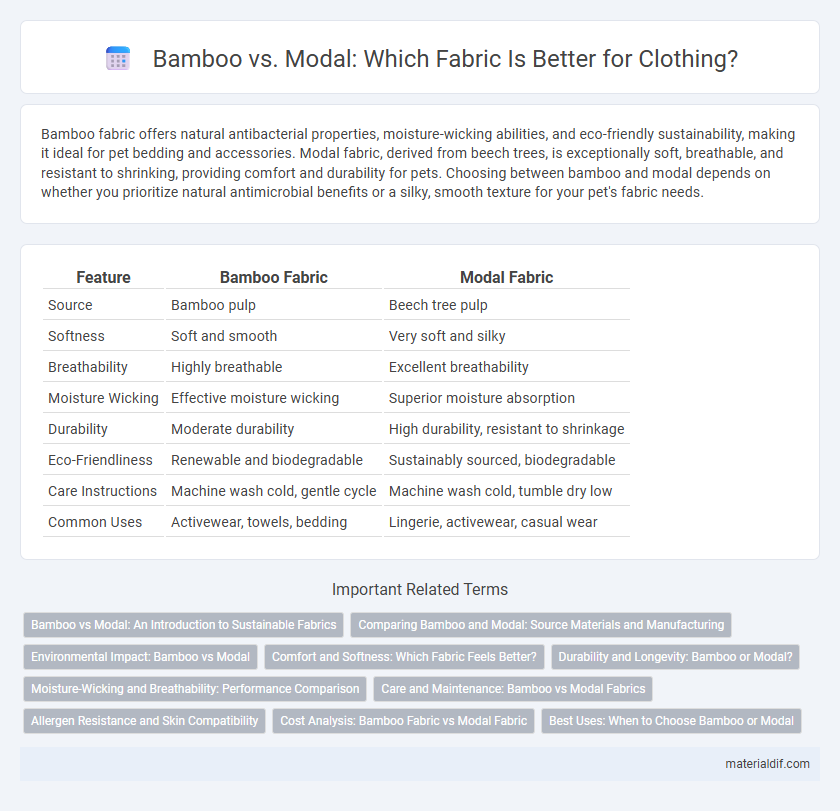Bamboo fabric offers natural antibacterial properties, moisture-wicking abilities, and eco-friendly sustainability, making it ideal for pet bedding and accessories. Modal fabric, derived from beech trees, is exceptionally soft, breathable, and resistant to shrinking, providing comfort and durability for pets. Choosing between bamboo and modal depends on whether you prioritize natural antimicrobial benefits or a silky, smooth texture for your pet's fabric needs.
Table of Comparison
| Feature | Bamboo Fabric | Modal Fabric |
|---|---|---|
| Source | Bamboo pulp | Beech tree pulp |
| Softness | Soft and smooth | Very soft and silky |
| Breathability | Highly breathable | Excellent breathability |
| Moisture Wicking | Effective moisture wicking | Superior moisture absorption |
| Durability | Moderate durability | High durability, resistant to shrinkage |
| Eco-Friendliness | Renewable and biodegradable | Sustainably sourced, biodegradable |
| Care Instructions | Machine wash cold, gentle cycle | Machine wash cold, tumble dry low |
| Common Uses | Activewear, towels, bedding | Lingerie, activewear, casual wear |
Bamboo vs Modal: An Introduction to Sustainable Fabrics
Bamboo fabric and modal are both sustainable textiles derived from natural cellulose fibers, with bamboo sourced from fast-growing bamboo plants and modal produced from beech tree pulp. Bamboo is praised for its natural antibacterial properties, moisture-wicking capabilities, and biodegradability, while modal is valued for its softness, breathability, and resistance to shrinking or pilling. Both fabrics offer eco-friendly alternatives to conventional cotton, but bamboo stands out for its rapid renewability and lower water usage in cultivation compared to modal's more intensive manufacturing process.
Comparing Bamboo and Modal: Source Materials and Manufacturing
Bamboo fabric originates from bamboo plants, processed through chemical treatments to transform cellulose fibers into soft, breathable textiles, while modal is derived from beech tree pulp using a similar but more eco-friendly spinning process. Bamboo production often involves intensive chemical use, raising environmental concerns, whereas modal manufacturing employs closed-loop systems that recycle chemicals, reducing waste and pollution. Both fabrics offer sustainable alternatives to conventional cotton, but modal typically scores higher in environmental impact due to its more efficient and responsible production methods.
Environmental Impact: Bamboo vs Modal
Bamboo fabric is often praised for its sustainability due to rapid growth and minimal pesticide use, but its processing can involve chemically intensive methods that impact the environment. Modal, a type of rayon made from beech tree pulp, is produced through a more eco-friendly process with lower water and energy consumption and often sourced from sustainably managed forests. Both fabrics offer biodegradable options, yet the environmental impact depends heavily on production practices and certifications like OEKO-TEX or FSC.
Comfort and Softness: Which Fabric Feels Better?
Bamboo fabric is highly praised for its exceptional softness and natural breathability, offering a silky smooth texture that feels cool against the skin, making it ideal for sensitive skin and hot climates. Modal, derived from beech trees, boasts a luxurious softness with excellent moisture-wicking properties and a slight stretch, enhancing comfort during movement. Both fabrics provide superior softness compared to traditional cotton, but bamboo stands out for its hypoallergenic qualities, while modal excels in durability and resistance to shrinking.
Durability and Longevity: Bamboo or Modal?
Bamboo fabric is known for its natural antimicrobial properties and resistance to pilling, enhancing its durability over time. Modal, made from beech tree pulp, offers excellent strength and maintains its softness even after multiple washes, making it highly durable as well. When comparing longevity, bamboo tends to be more breathable and naturally resilient, while modal's smooth texture and resistance to shrinking contribute to a lasting fabric lifespan.
Moisture-Wicking and Breathability: Performance Comparison
Bamboo fabric exhibits superior moisture-wicking properties due to its highly absorbent micro-gaps, efficiently drawing sweat away from the skin and promoting quick evaporation. Modal, crafted from beech tree pulp, also offers excellent breathability but tends to retain slightly more moisture compared to bamboo, making it less effective in keeping the wearer dry during intense activities. Both fabrics provide natural ventilation, yet bamboo's inherent antibacterial qualities further enhance its performance by reducing odor and maintaining freshness.
Care and Maintenance: Bamboo vs Modal Fabrics
Bamboo fabric requires gentle washing in cold water with mild detergent to maintain its softness and durability, and it is best air-dried to prevent shrinkage. Modal fabric, made from beech trees, is more resistant to shrinkage and can often withstand machine washing on a gentle cycle, but should be air-dried or tumble dried on low heat to preserve its silky texture. Both fabrics benefit from avoiding bleach and high heat to extend their lifespan and maintain fiber integrity.
Allergen Resistance and Skin Compatibility
Bamboo fabric offers excellent allergen resistance due to its natural antibacterial and hypoallergenic properties, making it suitable for sensitive skin and reducing irritation risks. Modal, derived from beech tree pulp, is also skin-friendly but can cause reactions in individuals with specific cellulose allergies, though it is generally breathable and smooth. Both materials promote skin compatibility, but bamboo's antimicrobial benefits give it an edge in minimizing allergic responses.
Cost Analysis: Bamboo Fabric vs Modal Fabric
Bamboo fabric typically costs more than modal fabric due to its eco-friendly production processes and natural antibacterial properties, making it a premium choice for sustainable textiles. Modal fabric, derived from beech trees, offers a more cost-effective alternative with excellent softness and durability, appealing to budget-conscious consumers. When comparing cost-efficiency, modal provides greater affordability while bamboo delivers added value through eco-conscious benefits, influencing purchasing decisions in the textile industry.
Best Uses: When to Choose Bamboo or Modal
Bamboo fabric excels in activewear and eco-friendly clothing due to its moisture-wicking and antibacterial properties, making it ideal for sportswear and casual wear. Modal is best suited for luxurious loungewear and underwear because of its silky softness and excellent drape, providing superior comfort against the skin. Choosing bamboo fabric is optimal for sustainability-conscious consumers seeking breathability, while modal suits those prioritizing softness and durability in everyday garments.
Bamboo vs Modal Infographic

 materialdif.com
materialdif.com